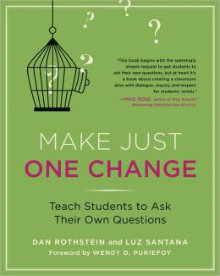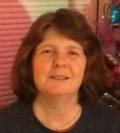Teach Students to Ask Their Own Questions
Make Just One Change: Teach Students to Ask Their Own Questions
By Dan Rothstein and Luz Santana
(Harvard Education Press, 2011 – Learn more)
Make Just One Change argues that shifting from teacher directed questioning to student directed questioning will revolutionize education and change the outcomes for all students from top achievers to those who struggle.

This insight led the authors to create the Question Formulation Technique (QFT) which they began implementing in the GED classes they taught. Their success in this environment has lead them to pursue QFT implementation in the K-12 setting.
A guide to implementing QFT
Most of the rest of the book is a step-by-step guide to implementing QFT in the classroom. It is a seemingly simple technique, but needs to be implemented with care to achieve the best results.
Done correctly, QFT causes students to think more deeply, devise and refine their own questions and prioritize their use, and develop skills in divergent and convergent thinking as well as metacognition. It motivates students to pursue more rigorous undertakings and assume ownership of their own learning.
Chapters 2-8 take teachers through the steps to successful implementation and the nuances associated with each step, revealing how these activities produce the desired results in students.
The authors talk about the first time the technique is implemented and what the teacher needs to look for and do versus later iterations of the technique once students have become familiar with it.
Each chapter also looks at specific examples within “trial classrooms” involving different age groups and content areas. These case-study classes are carried throughout the book and provide good real-world examples of how QFT can work.
The seven steps of the technique include: (1) The Question Focus, (2) Rules for Producing Questions, (3) Categorizing open- and closed-ended questions, (4) Improving the questions, (5) Prioritizing the questions, (6) Next steps (using the questions), and (7) Reflection.
From the classroom to the wider community
In the final chapters, the authors come back to their argument for the implementation of this technique. They first provide a chapter that features feedback from teachers who have implemented QFT about what they learned from the experiences. Rothstein and Santana follow this with a chapter on how using this technique can and does transform education and create a community of self-directed learners.
The authors conclude the book with a chapter that looks at the role this technique and its subsequent results could play in the larger context of our society and a democratic way of life.
While I agreed with their arguments, the final chapter seemed a bit grandiose, but one could see the point. The chapters on the steps to using the technique were highly informative and well written.
Deeper thinking and learning that result from students generating their own questions is definitely the direction we need to be moving in education, and this handy guide is sure to prove useful as we consider that move. I will be trying this out in my spring classes.
Laura Von Staden is a Special Education Middle School Teacher in Tampa, Florida. She serves on numerous committees both at her school and within her district and works closely with the local university where she is a Professional Practice Partner and a master mentor. Dr. Von Staden also facilitates both online and face-to-face Professional Development for her school district.



































